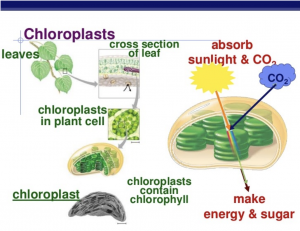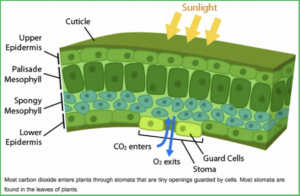Photosynthesis
How plants make food from sunlight, air, and water
Learning Objectives
Know reactants and products and what organelle the processes occur in. Understand the role of chlorophyll and stomata
Just like certain organisms need cellular respiration in order to sustain life, plants go through a process called photosynthesis. Photosynthesis is a plant’s process of converting light energy into chemical energy that it can live off of.
Plants are photoautotrophs, which means they are able to produce their own food from light. In other words, just like humans need food for energy, plants need light. Plants use solar energy (sunlight), carbon dioxide, andwater in order to make glucose, which it uses as energy to live. Oxygen is also a byproduct of this process, which plants release into the air. This is convenient for humans and other animals who need oxygen to breathe.
Plants need a certain amount of carbon dioxide and water in order to complete this process. The exact equation is shown here:
6 carbon dioxide molecules + 6 water molecules → 1 glucose molecule and 6 oxygen molecules
Photosynthesis takes place in organelles within the plant called chloroplasts. Chloroplasts give plants their green color, and contain chlorophyll, which carry out the functions of converting the sunlight absorbed by the plant into chemical, usable energy. Chlorophyll is located in the mesophyll, which is the middle layer of leaf tissue, as seen here in figure 2.

Light is absorbed through the top layers of the leaf, known as the cuticle and upper epidermis. We already know the mesophilic layers are where photosynthesis takes place, but what about the lower epidermis? The lower epidermis of a leaf contains stomata and guard cells that allow carbon dioxide to enter the leaf, and oxygen and excess water to exit the leaf. The structure of the leaf can be seen here in figure 3.

All of these parts work together to help the plant go through photosynthesis. Without this process, plants would not be able to produce and retain their energy.
Thanks for watching!
The process in which plants convert sunlight, carbon dioxide, and water into glucose (plant food).
Organisms which make their own food through the process of photosynthesis
light energy from the sun
(CO2) - The gas which is a byproduct of animal respiration that plants absorb during photosynthesis. The molecule consists of one central carbon atom and two oxygen molecules.
(H2O) - The clear liquid which is the basis of living organisms, found in rivers, lakes, and oceans. The compound consists of one central oxygen atom and two hydrogen atoms.
(C6H12O6) - The primary sugar which provides energy to the cells of living things.
The byproduct of photosynthesis, which animals use in respiration.
a specialized structure within a cell
The specialized cell structure in plants which converts sunlight into chemical energy
The molecule, known for its green pigmentation, that absorbs sunlight during photosynthesis
inner layer of leaf tissue
Waxy outer layer of the leaf which protects the epidermis
The clear layer of cells beneath the cuticle, which prevents water from escaping the leaf
The pores in the leaf which "breathe" in carbon dioxide and out oxygen
The cells which surround the stomata and control the "breathing" of the leaf by adjusting the size of the pores

